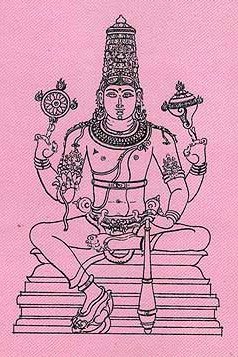Brahmavriksha, Brahmavṛkṣa, Brahman-vriksha: 10 definitions
Introduction:
Brahmavriksha means something in Hinduism, Sanskrit, biology. If you want to know the exact meaning, history, etymology or English translation of this term then check out the descriptions on this page. Add your comment or reference to a book if you want to contribute to this summary article.
The Sanskrit term Brahmavṛkṣa can be transliterated into English as Brahmavrksa or Brahmavriksha, using the IAST transliteration scheme (?).
In Hinduism
Purana and Itihasa (epic history)
Source: Cologne Digital Sanskrit Dictionaries: The Purana IndexBrahmavṛkṣa (ब्रह्मवृक्ष).—In Brahmaloka; only one tree; the śarira or body is tree and the Jīva is Īśvara.*
- * Vāyu-purāṇa 9. 116, 118-19.

The Purana (पुराण, purāṇas) refers to Sanskrit literature preserving ancient India’s vast cultural history, including historical legends, religious ceremonies, various arts and sciences. The eighteen mahapuranas total over 400,000 shlokas (metrical couplets) and date to at least several centuries BCE.
Pancaratra (worship of Nārāyaṇa)
Source: eScholarship: Chapters 1-14 of the Hayasirsa PancaratraBrahmavṛkṣa (ब्रह्मवृक्ष) is mentioned as building material for the foundation of a temple, according to Hayaśirṣa Pañcarātra chapter 11.13-14.—Accordingly, “having repeatedly sprinkled with water by means of the water-pots, which have gold and so forth, eight aṅgulas with mud, and to one hasta with bricks etc. then he should make a foundation with mallets made of the Brahmavṛkṣa. He should fill the hole, except one pāda, and should have it made very leveled”.

Pancaratra (पाञ्चरात्र, pāñcarātra) represents a tradition of Hinduism where Narayana is revered and worshipped. Closeley related to Vaishnavism, the Pancaratra literature includes various Agamas and tantras incorporating many Vaishnava philosophies.
Biology (plants and animals)
Source: Google Books: CRC World Dictionary (Regional names)1) Brahmavriksha in India is the name of a plant defined with Butea monosperma in various botanical sources. This page contains potential references in Ayurveda, modern medicine, and other folk traditions or local practices It has the synonym Rudolphia frondosa (Willd.) Poir. (among others).
2) Brahmavriksha is also identified with Ficus racemosa It has the synonym Covellia glomerata Miq. (etc.).
Example references for further research on medicinal uses or toxicity (see latin names for full list):
· Numer. List (4549)
· Bulletin of the Torrey Botanical Club (1946)
· London Journal of Botany (1848)
· Species Plantarum
· Journal of Cytology and Genetics (1990)
· Species Plantarum, ed. 4
If you are looking for specific details regarding Brahmavriksha, for example extract dosage, health benefits, diet and recipes, chemical composition, side effects, pregnancy safety, have a look at these references.

This sections includes definitions from the five kingdoms of living things: Animals, Plants, Fungi, Protists and Monera. It will include both the official binomial nomenclature (scientific names usually in Latin) as well as regional spellings and variants.
Languages of India and abroad
Sanskrit dictionary
Source: DDSA: The practical Sanskrit-English dictionaryBrahmavṛkṣa (ब्रह्मवृक्ष).—
1) the Palāśa tree.
2) the Udumbara tree.
Derivable forms: brahmavṛkṣaḥ (ब्रह्मवृक्षः).
Brahmavṛkṣa is a Sanskrit compound consisting of the terms brahman and vṛkṣa (वृक्ष).
Source: Cologne Digital Sanskrit Dictionaries: Shabda-Sagara Sanskrit-English DictionaryBrahmavṛkṣa (ब्रह्मवृक्ष).—m.
(-kṣaḥ) 1. The Palash tree, (Butea frondosa.) 2. The glomer ous fig-tree. E. brahma a Brahma and vṛkṣa a tree.
Source: Cologne Digital Sanskrit Dictionaries: Monier-Williams Sanskrit-English Dictionary1) Brahmavṛkṣa (ब्रह्मवृक्ष):—[=brahma-vṛkṣa] [from brahma > brahman] m. the divine tree, Brahmă regarded as a tree, [Bhagavad-gītā [Scholiast or Commentator]]
2) [v.s. ...] Butea Frondosa or Ficus Glomerasa, [cf. Lexicographers, esp. such as amarasiṃha, halāyudha, hemacandra, etc.]
Source: Cologne Digital Sanskrit Dictionaries: Yates Sanskrit-English DictionaryBrahmavṛkṣa (ब्रह्मवृक्ष):—[brahma-vṛkṣa] (kṣaḥ) 1. m. The Palās tree.
[Sanskrit to German]
Sanskrit, also spelled संस्कृतम् (saṃskṛtam), is an ancient language of India commonly seen as the grandmother of the Indo-European language family (even English!). Closely allied with Prakrit and Pali, Sanskrit is more exhaustive in both grammar and terms and has the most extensive collection of literature in the world, greatly surpassing its sister-languages Greek and Latin.
Kannada-English dictionary
Source: Alar: Kannada-English corpusBrahmavṛkṣa (ಬ್ರಹ್ಮವೃಕ್ಷ):—
1) [noun] the tree Areca catechu of Arecaceae family; betel nut tree.
2) [noun] the mulberry tree (Morus alba or Morus indica) of Moraceae tree.
3) [noun] the tree Ficus religiosa of Moraceae family; the peepul tree.
4) [noun] the tree Butea frondosa of Papilionaceae famiy; the flame of the forest.
Kannada is a Dravidian language (as opposed to the Indo-European language family) mainly spoken in the southwestern region of India.
See also (Relevant definitions)
Partial matches: Vriksha, Brahman, Brahma.
Starts with: Brahmavriksham.
Full-text: Brahma vriksha, Brahmavana, Dahana, Dahaniya.
Relevant text
Search found 6 books and stories containing Brahmavriksha, Brahmavṛkṣa, Brahmavrksa, Brahman-vriksha, Brahman-vṛkṣa, Brahman-vrksa, Brahma-vriksha, Brahma-vṛkṣa, Brahma-vrksa, Brahmavrikshe, Brahmavṛkṣe, Brahma-vrikshe, Brahma-vṛkṣe, Brahma-vrkse, Brahmavrkse; (plurals include: Brahmavrikshas, Brahmavṛkṣas, Brahmavrksas, vrikshas, vṛkṣas, vrksas, Brahmavrikshes, Brahmavṛkṣes, vrikshes, vṛkṣes, vrkses, Brahmavrkses). You can also click to the full overview containing English textual excerpts. Below are direct links for the most relevant articles:
The Skanda Purana (by G. V. Tagare)
Chapter 248 - Greatness of Palāśa Tree < [Section 1 - Tīrtha-māhātmya]
Chapter 263 - Origin of Matsyendranātha (Matsyendra-nātha) < [Section 1 - Tīrtha-māhātmya]
Chapter 15 - The Greatness of Dāmodara < [Section 2 - Vastrāpatha-kṣetra-māhātmya]
The Linga Purana (by J. L. Shastri)
Chapter 6 - The origin and activities of Alakṣmī < [Section 2 - Pūrvabhāga]
The Padma Purana (by N.A. Deshpande)
Chapter 14 - Sumanā Describes the Death of the Virtuous < [Section 2 - Bhūmi-khaṇḍa (section on the earth)]
Atharvaveda and Charaka Samhita (by Laxmi Maji)
Gynaecology and Pediatrics in the Atharvaveda < [Chapter 3 - Diseases and Remedial measures (described in Atharvaveda)]
Bhagavad-gita-rahasya (or Karma-yoga Shastra) (by Bhalchandra Sitaram Sukthankar)
Amarakoshodghatana of Kshirasvamin (study) (by A. Yamuna Devi)